by Mark Noppe
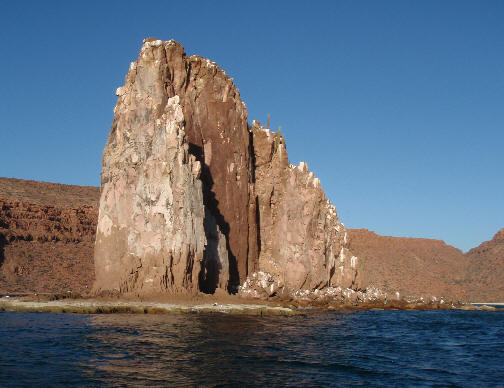
In February 2009, I paddled beautiful green and blue waters for 5 days and camped on white sandy beaches for 4 nights, exploring a chain of uninhabited desert islands in the Sea of Cortez, off the south east coast of Baja California Sur, Mexico. I stopped to swim and snorkel amongst sea lions, whale sharks, and colourful schools of fish. Every day was sunny and 25 to 30 C. It was a leisurely, solo winter adventure, and an economical and active alternative to a resort style vacation.
I had often dreamed about paddling in the Sea of Cortez, especially as a winter break, but it seemed quite surreal that on a whim, my Baja dream came true. On a freezing day in January 2009, I booked an inexpensive, last-minute, airplane-ticket-only deal to San Jose Del Cabo in Mexico. It was a 5 hour direct charter flight, departing Toronto on January 31 and returning 7 days later.
Ideally, I would have preferred to paddle with other people but no partners were available on such short notice. So, on my own, I needed to quickly decide where exactly in the Sea of Cortez I would paddle, how I would get there, where to stay before and after my trip, what I needed to bring with me, what I could expect to buy locally once I got there, and where I could rent a kayak. Plus, I needed to study local topics such as marine, animal and insect life, weather and wind patterns, tide tables, currents and shoals. From a standing start, with no knowledge of the Baja, I had less than one week to plan everything before my departure! For the next 4 days, I busied myself on the web, phone, and I read two travel guides. My main theme was, “let’s do this on the cheap, with safety in mind, getting the best adventure at the best value.”
I quickly learned that there are more than a few great kayaking areas along the east coast of the 1,600-kilometre long Baja California Sur peninsula. In the end, I decided that I would launch from La Paz, which is one of the southern most major kayaking areas. This would mean a 3-hour bus ride from San Jose Del Cabo northeast to La Paz. At La Paz, I would stay two nights, allowing one full day to organize my gear, buy groceries, stroll around town as time allowed, and also to allow for a time buffer. (As anyone who has travelled in Mexico knows, things can move more slowly than expected sometimes!)
I downloaded a very basic map and cross-referenced that with a guidebook and I planned out a rough draft of a 5-day, 4-night itinerary. I would paddle south, down the west coast of Isla Partida and Isla Espiritu Santo, encountering other smaller islands. These old volcanic islands are off the coast east of La Paz and they were made a national park in 2003. Isla Espiritu Santo is the larger island and by Great Lakes terms, it is relatively small at about 22 kilometres long and 55-kilometres around. That distance is potentially amplified considerably though by the many deep set coves that provide for a variety of scenic and sheltered paddling.
These are desert islands so the landscape is very dry, with lots of cactus and the occasional scrubby vegetation, but absolutely no trees. The topography is that of volcanic rock hills in the east and centre of the island, sloping down to coves and sandy beaches on the west side. Although the daytime temperatures during February can be in the 20 to 25 C range, the night time temperatures are typically in the 5 to 10 C range.
Beautiful camping sites abound on sandy beaches on the west side, whereas the east side of the island chain reminds me of the east side of the Bruce Peninsula with many cliffs and relatively fewer landing spots. In the Sea of Cortez, the winds typically blow from the northeast so the west side of the island chain also offers more shelter.
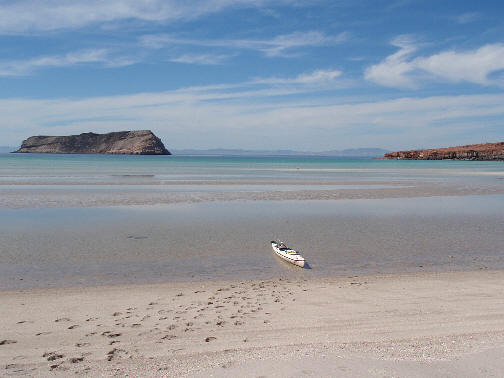
At the very southern tip of the chain, the islands are only about 7 kilometres from Tecolote Beach on the mainland, which is only about a 30-minute drive from La Paz. Although it might be possible for high endurance and highly skilled kayakers, paddling in a group, to make the crossing on a moderate day, it is not recommended to make this crossing during the winter months of December to February. There are strong currents flowing out to the Sea of Cortez, combined with the possibility of 15-foot swells. At other times of the year, paddling in an experienced group with local knowledge, and with a few extra days available, it may be quite viable to camp out on Tecolote, and wait for a good early morning crossing day.
Paddling solo, my only option was to hire a skiff or “panga” boat to transport me from the marina in La Paz, with boat and gear, for a 2-hour ride to the north end of the islands. Five days later, the same boat would pick me up on a pre-arranged beach at the south end of the island chain.
Using e-mail and telephone, I reserved my panga boat, hotel, a sea kayak rental, paddle and safety gear from Mar Y Aventuras, a reputable and longstanding local outfitter in La Paz. They were very responsive and friendly and we communicated in English with no problems whatsoever.
I could have rented absolutely everything in La Paz, but, because this was my first trip to the Baja and I was travelling alone, I did not want to leave much to chance. I decided instead to bring all my own camping gear, dive mask and snorkel. I also brought some sea kayak gear too: including my PFD, shorty wet suit, paddle jacket, deck compass, sandals, dry bags, GPS and my 6 watt marine VHF transceiver. I was able to cram everything into a backpack and a medium sized duffle bag.
Saturday January 31
My flight from Toronto to Cabo went off without a hitch and I took a taxi from the airport to the bus terminal in San Jose Del Cabo. On my arrival in La Paz I stayed for two nights at Posada LunaSol, a hotel with 14 rooms and a full communal kitchen. It is owned by Mar Y Aventuras, with their outfitter facility conveniently located on the main level.
La Paz, or in English, “The Peace”, is aptly named. It is a traditional Mexican city, of 250,000, known for its sunsets, with palm trees and beautiful pastel coloured buildings. The pace is slow and relaxing, the local people are friendly, and the various restaurants (no chains) offer an awesome selection of fresh food at very reasonable prices.
Sunday, February 1
On Sunday morning, I strolled the Malecon, which is a beautiful wide, tiled walkway that runs for several kilometres along the waterfront, following the curvature of the La Paz Bay. In the afternoon, I walked 7 blocks from the hotell to the CCC supermarket and bought my groceries and 5 x 1 gallon jugs of purified water. (Various guides indicate that there are two fresh water sources on the island, but I found one of them to be brackish and I didn’t bother checking the other.) The selection and freshness of groceries at CCC was everything that you would expect to find at home, although they did not have a bulk food section.
I arrived back at my hotel at 6:30 p.m. and a beautiful sun was setting. My pulse was beating quickly with my excitement as I repacked my gear into dry bags and sorted out my groceries. The forecast was for sun and 26 C with 15 knot winds for Monday and the outlook for the week was for sun every day, with winds tapering off to 5 knots and temperatures in the 26-30 C range. All my frenzied hours of planning were coming together very nicely.
Monday February 2
The two hour time difference made it very easy for me to rise early on Monday morning, the day of my departure. After breakfast, I met with Sergio from Mar Y Aventuras, inspected my boat and gear and rented a pair of diving fins and an MSR bottle of white stove fuel. (I brought my stove.)
I purchased a laminated plastic map of the islands from Mar Y Aventuras and reviewed it with Sergio. We discussed campsites, guidelines and park rules pertaining to Isla Espiritu Santo and Isla Partida. I remembered as I was leaving, how I was looking forward to a paddling trip without the nuisance of bears and raccoons for a change. As it turns out, there is a pesky (but cute) nocturnal little critter on the islands called a ring-tailed cat that likes to forage for food and garbage at night. The cat also likes to collect trophies like beach sandals, etc. A completely clean campsite, with all food and garbage stored in your hatch was the remedy. I also learned that the rattlesnakes, scorpions and spiders do not come down onto the beaches. So you have nothing to worry about unless you are hiking. Then, if you stay on the trails, wear shoes and keep your eyes and ears open, you should be okay.
Sergio reviewed my planned itinerary and I made some adjustments based on his suggestions. Essentially I was filing my “float plan” with him. Friends and family at home had Sergio’s e-mail and phone number. Cell phones only work at the very south end of the island. So I pre-tuned my VHF transceiver to Channel 6 which is the Mar Y Aventuras Base Camp on Isla Espiritu Santo. If I had ever needed help, I could have contacted the base camp and they would have been able to find me by boat within 30 minutes.
We departed in our panga from Marina La Paz at 9:30 a.m.; I was the only passenger. I encountered my first surprise just outside the La Paz bay when Alekandre, my panga driver, yelled excitedly “Shark.” And there they were: five whale sharks ranging from 15 to 25 feet long with jaws 2 to 3 feet wide and full racks of whale like “filtering teeth.” Alekandre insisted that I could and should go in snorkelling right away with my camera to get pictures. I stripped down to nothing and immediately dove into the water and swam around for at least 20 minutes with these enormous creatures.
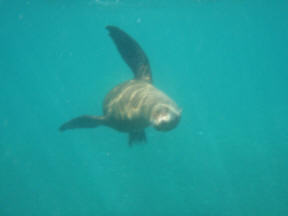
Alekandre dropped me and my gear on a small sandy beach on the south end of Ensenada Grande Bay on Isla Partida. This is a deep set cove with shallow water and steep hills and cliffs surrounding it. The wind was howling at this point with sand flying everywhere and I found it quite challenging to set up my tent. Anything not sitting under a rock would blow away immediately. At one point, my rear hatch blew away and after bouncing several times off the rocks, it landed way out in the water. I was still wearing my wet suit so I grabbed my fins and I dove in immediately and swam out to retrieve it. Surprisingly, it was only scratched, but not broken.
I had only seen a few people all day. While I was inflating my air mattress inside my tent, I was surprised to hear voices and clunking of boats on my beach. I jumped out of my tent to see four smiling kayakers on my beach. Laurie, Caroline, Julie, and Micky were all from San Francisco and they were camped with two others on the beach just north of me. They invited me over for dinner, which I accepted. They were an interesting and generous group of individuals; we had a beautiful dinner, telling stories and laughing. I paddled back to my tent in the moonlight with a sea lion following me.
Tuesday, February 3
I woke up to a beautiful sunrise but the wind was still ripping. It was a struggle to make breakfast. Even though the sun was beating down and it was a gorgeous day, I was feeling quite concerned about the wind. I wanted to get moving and exploring but I was following a strict, but simple decision-making process and the result was a No-Go. After breaking camp, I sat on the beach with my book and gazed out towards the open sea. By around noon, the wind was tapering off, so I decided to set out.
I had a glorious paddle, following the current south, with the wind at my back. The sun was bright and the water was sparkling brilliantly. I was singing gleefully at the top of my lungs as I paddled with the assistance of gentle 6- to 8-foot swells. Navigation was a cinch compared to the islands of Georgian Bay. My map was great. The water temperature was 18 C and the air was 27 C.
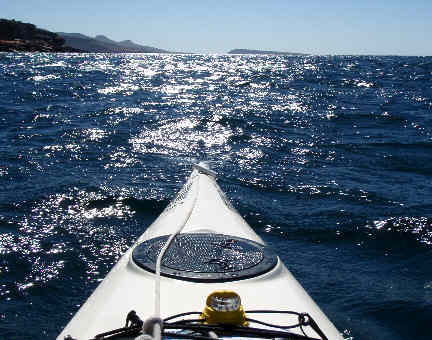
My California hosts served a beautiful lunch and insisted that it was their pleasure. A few of us paddled that afternoon south to Candeloro Bay, where the Mar Y Aventuras base camp is located. (This is an option for less experienced kayakers or those looking to eliminate the logistics associated with self-guided camping. Meals, beverages, tents and kayaks are provided and you can paddle around the area each day at your leisure. There are outhouses and a shower rigged up for guest use.)
On Tuesday afternoon, the wind virtually disappeared, never to be heard from again for the rest of my trip. My stress from a hectic northern winter had completed peeled away. After dinner with my new friends, I decided to stay Wednesday night as well, and spend all day Wednesday paddling around the area. We had a couple of astronomers in the group and every night the sky was brilliant, lit by a large moon with a beautiful halo. We learned about the constellations as we lay back, sipping hot peppermint tea in awe of our own natural planetarium.
Wednesday, February 4
I awoke to a dead calm morning. I watched the sun rise and made coffee and oatmeal while being entertained by squadrons of pelicans flying in formation and dive bombing for their breakfast in the shallow water. As a group we decided to pack a lunch and paddle north and explore the Caleta Partida channel. There was fishing camp here with several huts on the beach. The fishing is awesome everywhere so I recommend bringing your gear. You can also easily purchase fresh fish from the many fishermen that you will see on a trip like this.
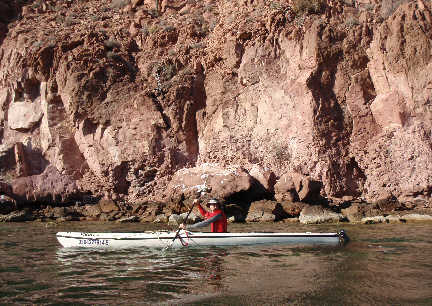
Thursday, February 5
I rose early to yet another perfect day and sunrise. After watching the daily pelican show and having breakfast, I quickly broke camp and bade farewell to my friends. I paddled south lazily for about 15 kilometres, meandering around Isla Ballena, Isla Gallo, into deep coves, mangroves, following sea lions. A group of dolphins splashed past me. I saw only 3 boats during the entire day and always at a distance. I stopped for lunch and a swim on Playa de Ballena which is a large beach that is designated as a No Camping area to protect its archaeological value. I pulled up at Playa Coralito for the evening. This is a beautiful mid-sized beach so named for the lovely little coral shoal that extends along its northern shore. I spent the afternoon snorkelling right off the beach.
I had time in the afternoon to paddle south for about 4 kilometres to San Gabriel Bay where I went on a 2-hour hike east over to Playa Bonanza and back. I paddled hard back to Playa Coralito to watch a beautiful sunset as I prepared a massive feast. I awoke in the middle of the night and, looking outside, I was sure that the beach was covered with snow! In actual fact, there was a light, night dew shimmering on the white, broken pieces of coral on the beach. The moon was low and almost full, shining a massive glow and bright white reflection of light off the beach that created the illusion of snow.
Friday February 6
After a delectable hot breakfast of hash brown potatoes, fresh guacamole prepared from my now blackened avocados, fried onions, dried chorizo sausage, wrapped in soft whole wheat tortilla shells, I went snorkelling for about 30 minutes. I broke camp and was just finished packing my gear, as Alekandre pulled up in the panga. It was 9:30 a.m. and he had a tour group onboard the panga. As an unexpected bonus, instead of going back to La Paz, we rode north back up to Los Isoltes to snorkel with the baby sea lions again. We followed a massive blue whale for 90 minutes and took several pictures. It came up for 3 to 5 minutes and then dove for 15 to 20 minutes. We stopped at the Mar Y Aventuras base camp for lunch and did some kayaking around the bay,.and arrived back at Marina La Paz at 6:30 p.m. with the sun setting. As I walked back to the hotel, I felt completely relaxed and at ease. My entire trip had gone like clockwork.
I would definitely recommend a trip like this to anyone who is looking for an eco-adventure, combined with a warm winter break, a cultural experience and an economical price tag. I will do this trip again. I lucked out: the wind conditions can be extremely dangerous in the Sea of Cortez and I was very fortunate to have such unseasonably calm seas. Now that I know better what to expect, next time, I will try to go with a group of people.
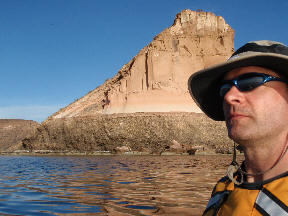
View maps of the trip: Baja California Sur and Isla Espiritu.
Note: These maps are for illustration purposes only. Do not use them for navigation as neither is 100% accurate.
